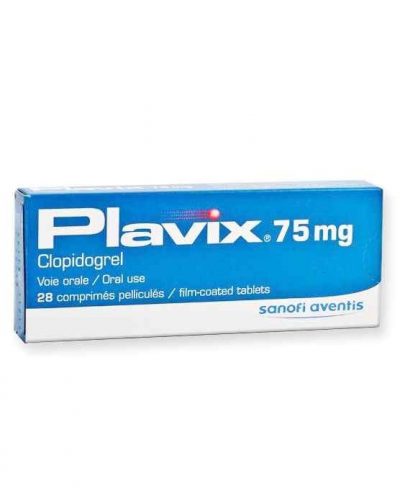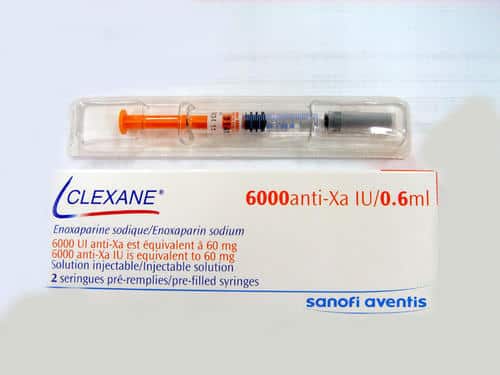- لا يوجد منتجات
-
VAXATO 10 MG 10 TAB فاكساتو
EGP170.00
** CLEXANE® (enoxaparin sodium) 6000anti-Xa IU/0.6ml 2 pre-filled syringes. Injectable solution. Subcutaneous route.
** Heparin analougue, S.C. injection (except for patients treated for myocardial infarction for whom an initial I.V. injection is required). Do not inject intramuscularly.
** Composition:
For one pre-filled syringe:
Enoxaparin sodium 60 mg
Water for injections q.s. ad 0.6 ml
** When should this drug be used (Therapeutic indications):
Solution for injection (containing 6000 anti-Xa IU, 8000 anti-Xa IU and 1000 anti-Xa IU:
– Treatment of deep vein thrombosis, with or without pulmonary embolism.
– Treatment of unstable angina and non-Q-wave myocardial infarction, administered concurrently with aspirin.
– Prevention of thrombus formation in the extracorporeal circulation during haemodialysis.
** Posology and method of administration:
– Treatment of deep vein thrombosis with or without pulmonary embolism:
Enoxaparin sodium can be administered subcutaneously either as a single daily injection of 150 anti-Xa IU/kg or as twice daily injections of 100 anti-Xa IU/kg. In patients with complicated thromboembolic disorders, a dose of 100 anti-Xa IU/kg twice daily is recommended. Enoxaparin sodium treatment is usually prescribed for an average period of 10 days. Oral anticoagulant therapy should be initiated when appropriate and enoxaparin sodium treatment should be continued until a therapeutic anticoagulant effect has been achieved (International Normalisation Ratio 2 to 3).
– Treatment of unstable angina and non-Q-wave myocardial infarction:
The recommended dose of enoxaparin sodium is 100 anti-Xa IU/kg every 12 hours by subcutaneous injection, administered concurrently with oral aspirin (100 to 325mg once daily). Treatment with enoxaparin sodium in these patients should be prescribed for a minimum of 2 days and continued until clinical stabilisation. The usual duration of treatment is 2 to 8 days.
– Prevention of thrombus formation in extracorporeal circulation during haemodialysis:
The recommended dose of enoxaparin sodium is 100 anti-Xa IU/kg. For patients with a high risk of hemorrhage, the dose should be reduced to 50 anti-Xa IU/kg for double vascular access or 75 anti-Xa IU/kg for single vascular access. During hemodialysis enoxaparin sodium should be introduced into the arterial line of the circuit at the beginning of the dialysis session. The effect of this dose is usually sufficient for a 4-hour session. However, if fibrin rings are found, a further dose of 50 to 100 anti-Xa IU/kg may be given.
** Contraindications:
– in patients with known hypersensitivity (allergy) to either enoxaparin sodium, heparin or other Low Molecular Weight Heparins.
– in patients with active major bleeding and conditions with a high risk of uncontrolled haemorrhage, including recent haemorrhagic stroke.
** Special warnings:
– Low Molecular Weight Heparins should not be used interchangeably since they differ in their manufacturing process, molecular weights, specific anti Xa activities, units and dosage. Very careful attention and compliance with the specific instructions on use of each product are absolutely essential.
– Spinal / Epidural anesthesia.
– Heparin-induced thrombocytopenia:
Enoxaparin sodium is to be used with extreme caution in patients with a history of heparin-induced thrombocytopenia (decrease in blood platelet count) with or without thrombosis.
– Percutaneous coronary revascularisation procedures.
– Pregnant women with mechanical prosthetic heart valves.
– Laboratory tests.
** Precautions:
– Bleeding: As with other anticoagulants, bleeding may occur at any site. If bleeding occurs, the origin of the haemorrhage should be investigated and appropriate treatment instituted.
– Mechanical prosthetic heart valves.
– Haemorrhage in the elderly.
– Renal impairment.
– Low weight.
– Monitoring of platelet count.
** Pregnancy and lactation:
In humans, there is no evidence that enoxaparin crosses the placental barrier during the second trimester of pregnancy. There is no information available concerning the first and the third trimesters.
As there are no adequately powered and well-controlled studies in pregnant women enoxaparin sodium should be used during pregnancy only if the physician has established a clear need. Pregnant women with mechanical prosthetic heart valves may be at a higher risk of thromboembolism.
As a precaution, lactating mothers receiving enoxaparin sodium should be advised to avoid breast-feeding.
** Prescription only medicine – List I. Use the dose as prescribed.
** Read carefully the package insert before use.
** Do not store above 25 degrees C.
Keep out of the reach and sight of children.










المراجعات
لا توجد مراجعات بعد.